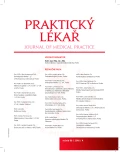Preview of physical activity in selected cancer patients
Authors:
E. Vaňásková 1; I. Vařeka 1,2; J. Vaňásek 3,4
Authors‘ workplace:
Univerzita Karlova v Praze
Lékařská fakulta a Fakultní nemocnice Hradec Králové
Rehabilitační klinika
Přednostka: doc. MUDr. Eva Vaňásková, Ph. D.
1; Univerzita Palackého v Olomouci
Fakulta tělesné kultury
Katedra fyzioterapie
Vedoucí: prof. MUDr. Jaroslav Opavský, CSc.
2; Univerzita Pardubice
Fakulta zdravotnických studií
Děkan: prof. MUDr. Josef Fusek, DrSc.
3; Onkologické centrum Pardubice, Multiscan s. r. o.
Primář: doc. MUDr. Jaroslav Vaňásek, CSc.
4
Published in:
Prakt. Lék. 2016; 96(4): 190-192
Category:
Of different specialties
Overview
Many studies have demonstrated a significant relationship between the intensity of regular physical activity and the incidence and prognosis of cancer. Sedentary lifestyle is associated with a higher risk of cancer. Using regular aerobic exercise combined with strengthening can positively influence the incidence of associated diseases and complications of cancer. However, only a small proportion of patients respects these active measures.
Keywords:
movement – physical activity – exercise – rehabilitation – cancer
Sources
1. Bourke L, Homer KE, Thaha MA, et al. Interventions for promoting habitual exercise in people living with and beyond cancer. Cochrane Database Syst Rev 2013; 9: CD010192. doi: 10.1002/14651858.CD010192.pub2.
2. Braam KI, van der Torre P, Takken T, et al. Physical exercise training interventions for children and young adults during and after treatment for childhood cancer. Cochrane Database Syst Rev 2013; 4: CD008796. doi: 10.1002/14651858.CD008796.pub2.
3. Courneya KS, Segal RJ, Mackey JR, et al. Effects of exercise dose and type on sleep quality in breast cancer patients receiving chemotherapy: a multicenter randomized trial. Breast Cancer Res Treat 2014; 144(2): 361–369.
4. Hildebrand JS, Gapstur SM, Campbell PT, et al. Recreational physical activity and leiure-time sitting in relation to postmenopausal breast cancer risk. Cancer Epidemiol Biomarkers Prev 2013; 22(10): 1906–1912.
5. Hradil V, Kittlerová-Trávníčková O. Rehabilitace v onkologii. Rehabil. fyz. Lék 2007; 14(4): 135–147.
6. Humpel N, Iverson DC. Sleep quality, fatigue and physical activity following cancer dignosis. Eur J Cancer Care 2010; 19(6): 761–768.
7. Khan F, Amatya B, Ng L, Demetrios M, et al. Multidisciplinary rehabilitation for follow-up of women treated for breast cancer. Cochrane Database Syst Rev 2012; 12: CD009553. doi: 10.1002/14651858.CD009553.pub2.
8. Kushi LH, Doyle C, McCullough M, et al. American Cancer Society Guidelines on nutrition and physical activity for cancer prevention: reducing the risk of cancer with healthy food choices and physical activity. CA Cancer J Clin 2012; 62(1): 30–67.
9. McNeely ML, Campbell KL, Rowe BH, et al. Effects of exercise on breast cancer patients and survivors: a systematic review and meta-analysis. CMAJ 2006; 175(1): 34–41.
10. Mishra SI, Scherer RW, Geigle PM, et al. Exercise interventions on health-related quality of life for cancer survivors. Cochrane Database Syst Rev 2012; 8: CD007566. doi: 10.1002/14651858.CD007566.pub2.
11. Moore SC, Patel AV, Matthews CE, et al. Leisure time physical activity of moderate to vigorous intensity and mortality: a large pooled cohort analysis. PLoS Med 2012; 9(11): e1001335.
12. Namik S, Arai Y. Health-releted quality of life a men with localized prostate cancer. Int J Urol 2010; 17(2): 125–138.
13. Pinto BM, Frierson GM, Rabin C, et al. Home-based physical activity intervention for breast cancer patients. J Clin Oncol 2005; 23(15): 3577–3587.
14. Puetz TW, Herring MP. Differential effects of exercise on cancer-related fatigue during and following treatment: a meta-analysis. Am J Prev Med 2012; 43(2): e1–e24.
15. Schmid D, Leitzmann MF. Association between physical activity and mortality among breast cancer and colorectal cancer survivors: a systematic review and meta-analysis. Ann Oncol 2014; 25(7): 1293–1311.
16. Slattery ML. Physical activity and colorectal cancer. Sports Medicine 2004; 34(4): 239–252.
17. Sturgeon KM, Ky B, Libonati JR, et al. The effects of exercise on cardiovascular outcomes before, during, and after treatment for breast cancer. Breast Cancer Res Treat 2014; 143(2): 219–226.
18. Valentová E, Vaňásková E, Odrážka K. Význam léčebné rehabilitace v léčbě urologických komplikací spojených s léčbou karcinomu prostaty. Rehabilitácia 2014; 51(1): 49–54.
19. Vaníkova K, Buchtelová E, Šlechtová D. Vliv operace prsu na pohybový systém. Rehabilitácia 2010; 47(3): 177–186.
20. Winters-Stone KM, Laudermilk M, Woo K, et al. Influence of weight training on skeletal health of breast cancer survivors with or at risk for breast cancer-related lymphedema. J Cancer Surviv 2014; 8(2): 260–268.
21. Wolin KY, Schwartz AL, Matthews CE, et al. Implementing the exercise guidelines for cancer survivors. J Support Oncol 2012; 10(5): 171–177.
22. Wolin KY, Luly J, Sutclife et al. Risk of urinary incontinence following prostatectomy: the role of physical activity and obesity. J Urol 2010; 183(2): 629–633.
Labels
General practitioner for children and adolescents General practitioner for adultsArticle was published in
General Practitioner

2016 Issue 4
Most read in this issue
- The purpose of MRI as a part of pre-surgery staging for breast cancer
- Genotype/phenotype correlation in Czech tuberous sclerosis patients
- Preview of physical activity in selected cancer patients
- Occupational diseases reported in the Czech Republic in 2015
